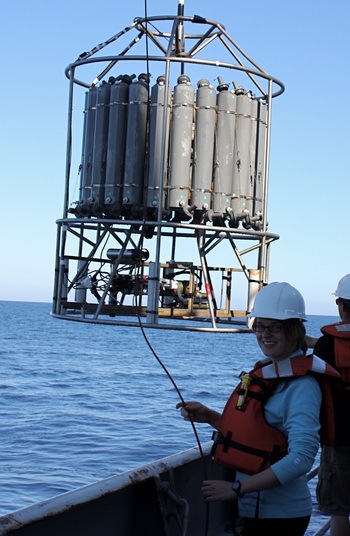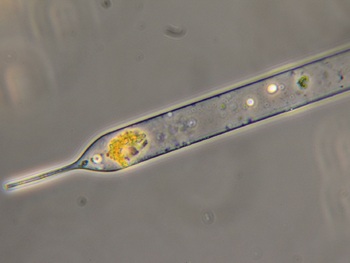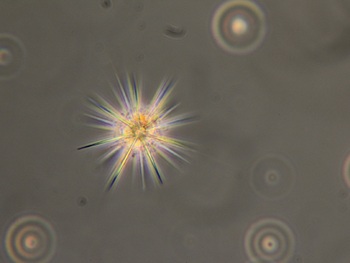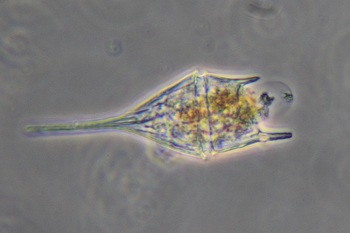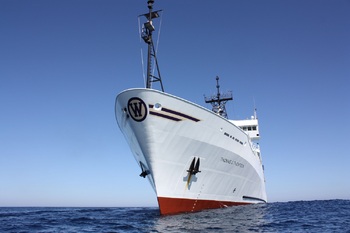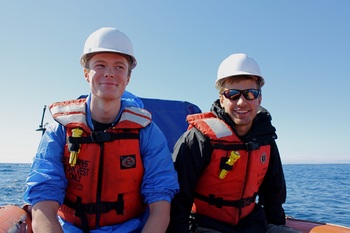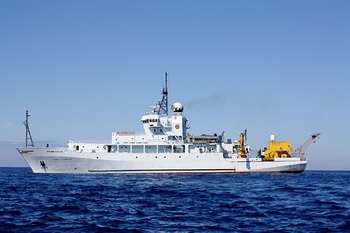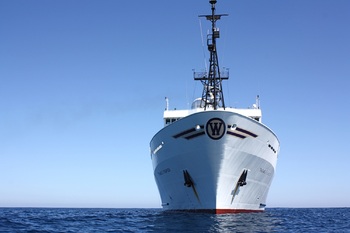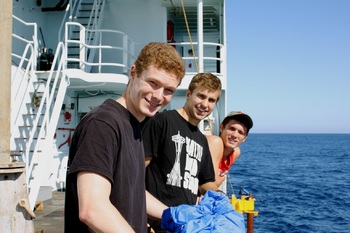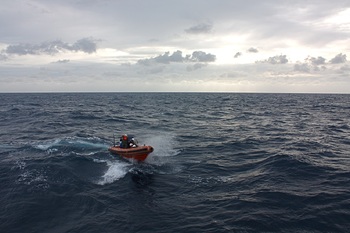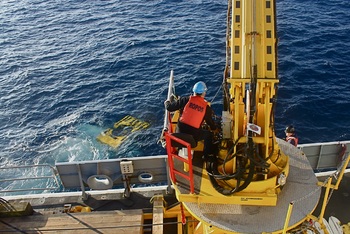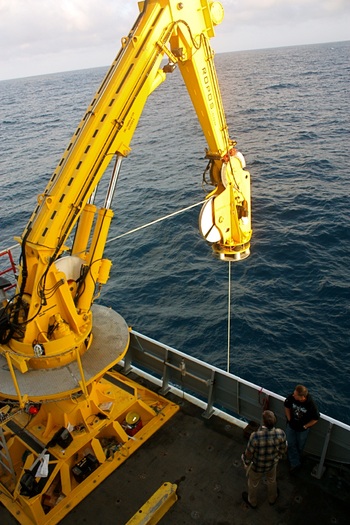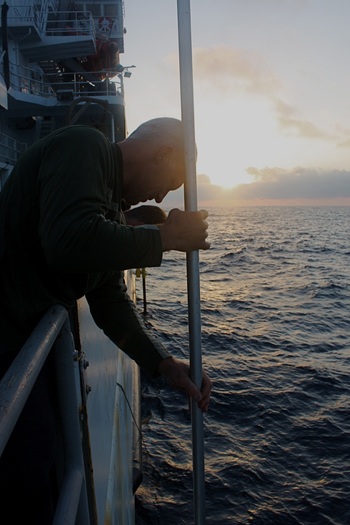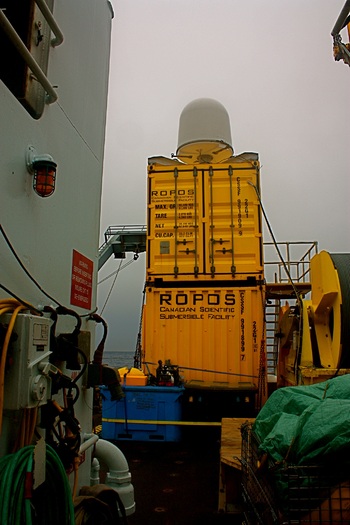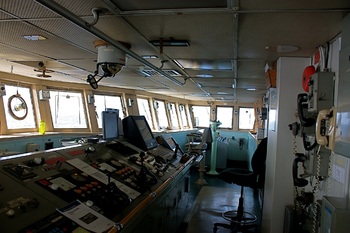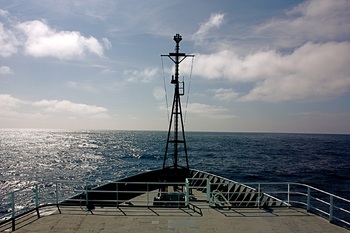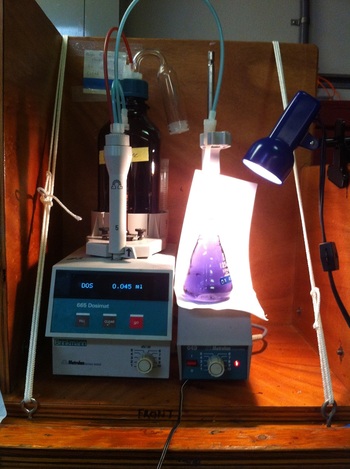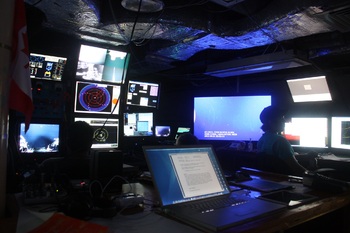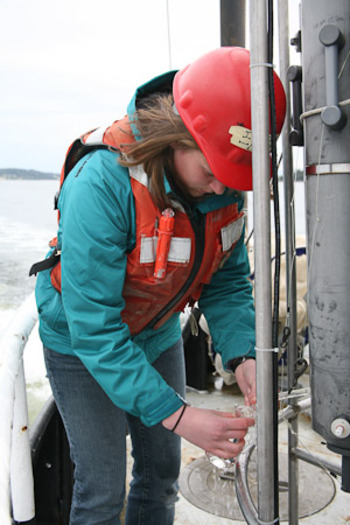Martha James

Phytoplankton
Tuesday, August 30, 2011
I ended up changing my cruise project from lava morphology/bathymetry mapping to looking at relative abundance of phytoplankton above Axial Seamount. Last year on this cruise I did a project related to geological & biological mapping of mosaicked images of the seafloor at Hydrate Ridge, so I’m glad I chose to do something else to broaden my knowledge base. Before this I have had very little experience doing cell counts of plankton, or any serious identification. I’ve been getting a lot of help, but I’ve loved it! In particular, I really enjoyed taking pictures of them. It’s a tricky process though; it’s surprisingly difficult to focus on the entire organism. These pictures are few of the ones I’ll be using in my final project presentation tomorrow.

Time flies!
Sunday, August 28, 2011
The ship is constantly active; at any given hour, you can walk through any room and find somebody up. There’s always something to distract you, something you learn about, or some data being collected. The time flies! Already, we have just over two days left at Axial; it’s amazing how quickly the cruise has gone by.
Watching the ROV roam the seafloor is still fascinating, but we’re past the initial stages of awe checking out the new lava flow and amazing collapse features. Lately we’ve been spending many hours thoroughly creating video documentation of the hydrothermal vents at different vent fields. Lots of sulfury, shiny rocks are being sampled. We’re trying out different sensors like temperature probes and current meters that may some day be permanent seafloor fixtures.
It’s truly evident how novel of a science and process this is. Rock sampling, for example, 1500 meters below the seafloor of new, fragile basalt is incredibly difficult even with the outstanding technologies present with the ROV. Using the ROV’s arms often results in crushing large chunks of basalt—the ease in which they seem to break apart resembles how a cracker might fare encased in those huge manipulators. On many occasions, the crew has resorted to using a vacuum-like device to slurp up the crumbled fragments instead. The hydrothermal vents are tricky to sample too. In some instances, the current created in getting too close results in sturdy-looking structures simply falling over.
And, everyday, I feel so lucky to spend these two weeks surrounded by such a variety of people. Everybody has such unique stories about how they came to this field, and everybody is an expert with so much to teach. Every time I get an enthused explanation by somebody who is clearly passionate about his or her work, I get briefly waylaid imagining myself in that respective field. It’s hard to say where I’ll end up, but it’s inevitable that I’ll pick something where I’ll continue to be able to come on these fantastic cruises.
New lava flows
Tuesday, August 23, 2011
Because Axial Seamount erupted so recently, we have a really unique opportunity to see what a seafloor lava flow looks like so soon after it occurs. During my watch today, we came across the new lava flow for the first time, and it was pretty incredible! Most of the lava we’ve been moving over since we arrived on site has been there for a while and is covered with some degree of sediment. Sometimes over sheet flows (really flat areas), there is so much sediment no lava is visible. The new lava, however, is deep black, and often shiny with volcanic glass. Massive, unperturbed pillow lavas cover extensive areas, and we started our exploration of this new area today. At one point we came across beautiful lava pillars holding up a ceiling of fresh lava flow—at one point magma flowed through this area in a lava tube and left behind only the pillars and ceiling which solidified before everything else.
My favorite lava feature, however, were the many lava whorls I saw today. Huge swirls in the lava rock are formed when sheet flows are moving next to each other at different rates, and essentially they swirl together to make these beautiful lava features.
As I’m writing this, I’m watching the live feed that is streaming in the main lab on the ship. We just came across snow blowers—an environment found, so far, only in fresh lava flows where plentiful white microbes and material produced by microbes flow out of holes in the sea floor in big snow-like chunks. Theory behind them is that after an eruption, voids under the seafloor are left from magma chambers which are soon filled with seawater seeping into the crust via cracks and crevices. The water is warm, and the perfect environment for these single-celled organisms to flourish. The rocks around the snow blower are covered in either white or rust-orange colors—most likely filamentous chemosynthetic bacteria that is thriving in the volcanic environment rich in carbon dioxide and hydrogen sulfide. Dr. Deb Kelley herself said the view we had on the snowblower tonight was the best thing she has seen on the seafloor.

Sunset
Monday, August 22, 2011
After spending hours staring at computer screens and getting thoroughly engrossed in the seafloor thousands of meters below us, it’s fantastic to have a sunny day. A beautiful sunset tonight brought many people out on deck to get some air, and helped remind us of the wonderful environment in which we are able to conduct our research.

2nd Watch
Monday, August 22, 2011
I had my second watch today. We covered over 6 km of a cable survey, making sure the cable was in a good position on the seafloor. On my watch it looked great--there were very few places it was tightly stretched at all. But last night, there were huge sections with the cable stretched over obstacles, and even an instance where the cable was laying directly on top of a hydrothermal vent. This will likely significantly lower the lasting age of the cable; sharp basalts and extremely high temperatures are best avoided.
Mostly as the ROV is moving over the seafloor we are seeing a mix of sediment cover and different lava morphologies—pillow basalts, sheet flows, and many collapse features are commonly seen. In addition, we see several different types of sea stars and fish. Today we saw our third dumbo octopus, and I took pictures of several skates on my watch. As a logger, it’s my job to make constant observations on the position of the cable and the changing sediment, basalt, and biota along the way. Visibility is limited as marine snow is constantly floating down in front of the ROV making the sea floor look like a winter storm. The highlight of the live feed, in my opinion, was the amazing footage captured last night of a dumbo octopus—I recently learned about these in a marine biology class and it was thrilling to see one move in real time.
After my watch, I visited the bridge for the best view on the ship. Tonight, I’m hoping to make some more progress on my project. I made some headway this morning with ArcMap, but I still have a ton to learn about how to best present the data.
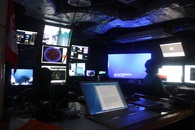
Day 2 & 3
Sunday, August 21, 2011
During the transit from Newport-Axial Seamount, I kept myself busy reading papers on lava morphologies of the area we’re headed to, and helping out in the wet lab. On Saturday early morning, a CTD cast and several water samples were taken. After a thorough refresher course on oxygen titrations, I spent a few hours late last night helping Orest Kawka analyze his water samples.
I woke up this morning and we had made it to Axial Seamount! My first watched for the ROPOS ROV started soon after the Slocum AUV was deployed. My watch, unfortunately, covered four hours of moving at about 900 meters depth. Luckily though, this gave me several opportunities to see beautiful jellyfish and even a squid. Now, the ROV is on the seafloor, tracking the location of the cable that was recently placed for the observatory.
Since the RSN team has been out here last, Axial erupted, covering portions of the caldera with thick lava. Everybody is eager to see the changes this has had on the region, and how this will affect plans for future node placement. I’m hoping to utilize the new data we collect to make a geological map of potential node sites to help determine the safest, yet most interesting, site for instrument placement.
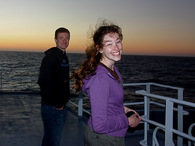
Day 1: Seattle-Newport
Saturday, August 20, 2011
Yesterday, Friday the 19th, the new Leg-2 participants took the long drive from Seattle-Newport, OR. All of the undergraduates, myself included, were clearly ecstatic to finally be on our way to the Visions ’11 research cruise. After a few hours of loading gear onto the ship and organizing on board, we set off. Fog was thick, and we quickly lost site of the shore. But, a few hours after leaving shore, the fog lifted and we got a glimpse of a beautiful sunset.
Until we reach Axial Seamount, which will take us about 30 hours from leaving Newport, we are mainly acclimatizing to the rolling ship, getting a more clear idea of our research projects, and slowly meeting people on board. Many faces are familiar from last year, but about an equal number are people I have yet to meet. It’s always interesting hearing individual stories about how people ended up on this particular research cruise. Mainly, I’m just excited to see Axial for the first time!
